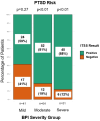Firearm injury survivors report extreme high risk for poor physical and mental health outcomes early after hospital discharge necessitating multidisciplinary care
- PMID: 39845993
- PMCID: PMC11749528
- DOI: 10.1136/tsaco-2023-001336
Firearm injury survivors report extreme high risk for poor physical and mental health outcomes early after hospital discharge necessitating multidisciplinary care
Abstract
Background: Up to 20-40% of survivors of any traumatic injury develop post-traumatic stress disorder (PTSD) or depression after injury. Firearm injury survivors may be at even higher risk for adverse outcomes. We aimed to characterize PTSD and depression risk, pain symptoms, and ongoing functional limitations in firearm injury survivors early after hospital discharge.
Methods: Firearm injury survivors seen in the Trauma Quality of Life (TQOL) outpatient follow-up clinic 1-2 weeks after discharge were invited to participate in a survey assessing both mental and physical health outcomes. The survey included the Brief Pain Inventory (BPI), the Injured Trauma Survivor Screen (ITSS), the Beck Depression Inventory (BDI), the PTSD Checklist for DSM-5 (PCL-5), and the 12-item Short Form Survey Physical Health component (SF-12).
Results: 306 patients were seen in the TQOL Clinic, and 175 responded to the survey. The mean age was 32 years (SD=12), 81% were male, and 79% were black. On the ITSS, 69% and 48% of patients screened risk positive for PTSD and depression, respectively. Patients reported mild depression symptoms with an average BDI score of 14.3 (SD=11.8) and elevated PTSD symptoms with an average PCL-5 score of 43.8 (SD=12.8). Patients with severe BPI scores were more likely to screen positive for depression and PTSD. Respondents scored >2 SD below the US national average on the SF-12 for physical quality of life (M=28.7). 12% of patients were at risk across all four domains of pain, PTSD, depression, and physical function.
Conclusion: Early after discharge, over two-thirds of firearm injury survivors were at risk for the development of PTSD, nearly half were at risk of depression, and physical function was significantly decreased. Trauma centers need to prioritize early, outpatient multidisciplinary care to treat and prevent the development of poor chronic physical and mental health for firearm injury survivors.
Level of evidence: III.
Keywords: Firearms; Stress Disorders, Post-Traumatic; patient outcome assessment; patient reported outcome measures.
Copyright © Author(s) (or their employer(s)) 2025. Re-use permitted under CC BY-NC. No commercial re-use. See rights and permissions. Published by BMJ Group.
Conflict of interest statement
None declared.
Figures

Comment in
-
Critical considerations to facilitate multidisciplinary care for survivors of firearm injury.Trauma Surg Acute Care Open. 2025 Feb 18;10(1):e001723. doi: 10.1136/tsaco-2024-001723. eCollection 2025. Trauma Surg Acute Care Open. 2025. PMID: 39975965 Free PMC article. No abstract available.
References
-
- Vella MA, Warshauer A, Tortorello G, Fernandez-Moure J, Giacolone J, Chen B, Cabulong A, Chreiman K, Sims C, Schwab CW, et al. Long-term Functional, Psychological, Emotional, and Social Outcomes in Survivors of Firearm Injuries. JAMA Surg. 2020;155:51–9. doi: 10.1001/jamasurg.2019.4533. - DOI - PMC - PubMed
-
- Haider AH, Herrera-Escobar JP, Al Rafai SS, Harlow AF, Apoj M, Nehra D, Kasotakis G, Brasel K, Kaafarani HMA, Velmahos G, et al. Factors Associated With Long-term Outcomes After Injury: Results of the Functional Outcomes and Recovery After Trauma Emergencies (FORTE) Multicenter Cohort Study. Ann Surg. 2020;271:1165–73. doi: 10.1097/SLA.0000000000003101. - DOI - PubMed
LinkOut - more resources
Full Text Sources
Research Materials
